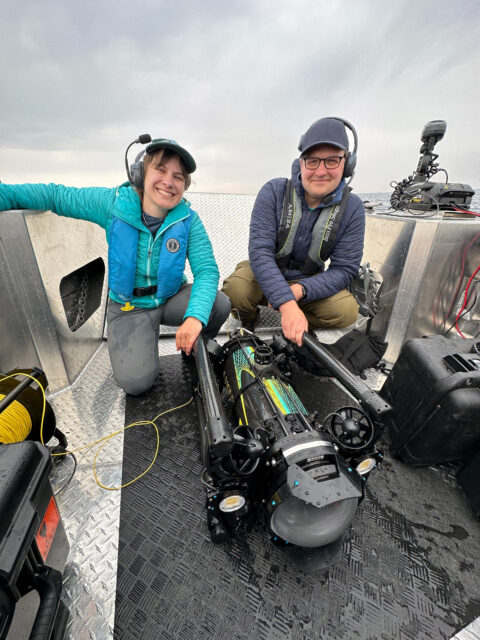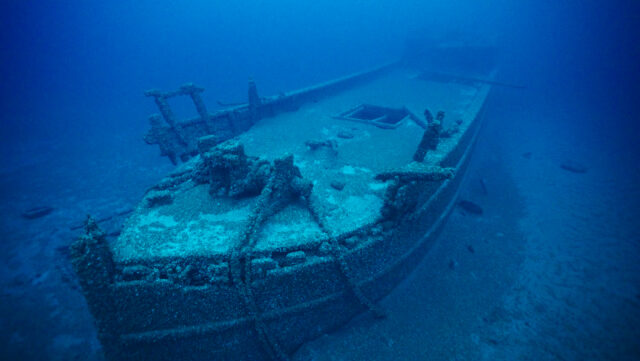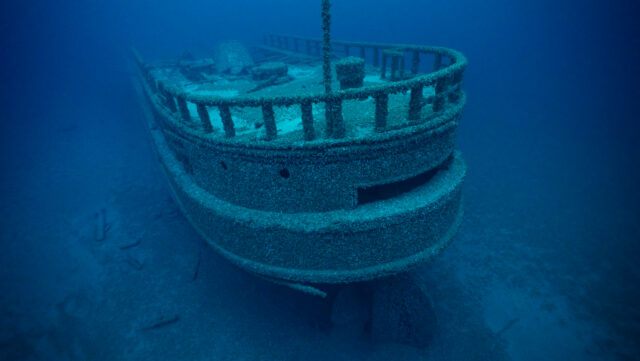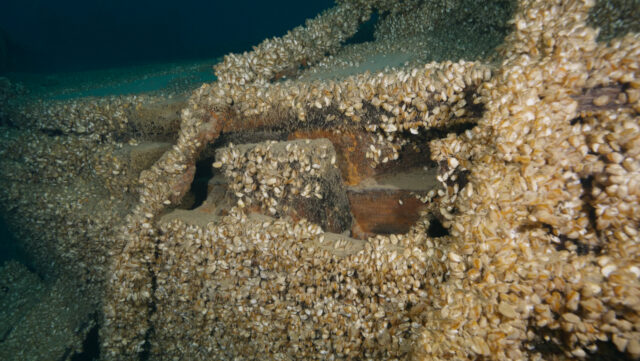While working on a documentary about invasive mussel species in the Great Lakes, a pair of filmmakers made an incredible discovery. Lost in Lake Huron for the last 128 years, they found the wreck of the steamship Africa. After enlisting the help of several maritime professionals, they were able to pinpoint the wreck’s location, solving the mystery of where the vessel had laid to rest all these years.
They were tipped off about a mysterious mound

discovery of the Africa, with their robot, Kiyi
(center). (Photo Credit: Esme Batten)
Yvonne Drebert and Zach Melnick, a husband-and-wife filmmaking duo, were gathering footage for their upcoming documentary, All Too Clear, when they heard word of a mysterious mound in Lake Huron that might be of interest to them. “We received a tip that scientists doing an offshore fish survey had noticed an anomaly on their sonar readout, basically an unusual bump on an otherwise flat lakebed,” Melnick explained.
Taking a trip out on their boat with some friends, they traveled to the spot and used their underwater drone, known as a remotely operated vehicle (ROV), to get a better look at what the mound really was. As the ROV descended deeper into the water, Drebert said, “we honestly expected to find a pile of rocks.” However, what they found was something entirely different.
Lying on the lakebed at around 280 feet below the surface was a wrecked vessel covered in quagga mussels. The ROV was able to clearly capture the wreck, leaving everyone onboard their boat speechless at what they had just discovered.
They needed help to identify the ship

With the vessel being entirely covered in mussels, the duo couldn’t quite make out what wreck they had come upon the first time they spotted it. In order to determine which ship they discovered, Drebert and Melnick had to enlist the help of local maritime historian Patrick Folke, as well as marine archaeologist Scarlett Janusas. After they acquired the necessary archaeological license from Ontario, the group took off to the site of the wreck once again to try and identify it.
This time around, they were able to get the vessel’s measurements, which would go a long way in helping them determine what ship they discovered. At 148 feet long, 26 feet wide, and 12.5 feet tall, the vessel’s measurements were consistent with that of the Africa. Additionally, found along the lakebed were pieces of coal, which matches up with the cargo the Africa was moving during its final journey. As such, the group is quite certain they have stumbled upon the long-missing Africa wreck.
The story of the Africa (and the Severn)

In early October of 1895, the Africa departed from Ashtabula, Ohio, with its intended destination being Owen Sound, Ontario. Along for the journey was the schooner named Severn, which was being towed by the Africa, both of which were holding a combined 1,270 tons of coal.
After just two days of travel, as the ships neared the Saugeen Peninsula, the weather on Lake Huron took a turn for the worse. A dangerous snowstorm began to rage, and the water became so uneasy that the captain of the Africa decided to have the Severn released from its tow line. The schooner then struck a reef, and those onboard were stranded until help reached them the following morning. Sadly, the Africa did not share the same fate. During the storm, the vessel disappeared, and all 11 crew members perished along with it.
James Silversides, the Severn‘s captain, spoke with a local newspaper following his rescue, saying, “I have passed through some bad weather during my 35 years’ sailing, but that experience upon Lake Huron is as bad as any,”.
The quagga mussels help and harm

Not only did the tip of where to find the mysterious mound help Drebert and Melnick locate the wreck, but the invasive quagga mussels they are studying for their documentary also played a part in their discovery. Quagga mussels filter the water around them as they extract microscopic particles for food. As such, the waters surrounding the Africa wreck were far more clear than they typically would be. “The quaggas are the reason we’re able to see the shipwreck in almost 300 feet of water without any additional lights,” Drebert explained.
However, the quaggas are capable of doing far more harm than good, especially in the jarring numbers with which they are invading the Great Lakes. Their presence is rapidly destroying the natural ecosystems in the lakes, and they are covering practically everything in a thick layer – including shipwrecks. “The mussels burrow into wooden vessels, building upon themselves in layers so thick they will eventually crush walls and decks,” wrote journalist Todd Richmond of the Associated Press. “They also produce acid that can corrode steel and iron ships.”
While their contribution to finding the long-lost Africa is appreciated, we agree that the quagga mussels in the Great Lakes have got to go.
